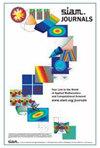受随机 PDE 约束的最优控制问题的组合技术
IF 1.9
3区 工程技术
Q2 MATHEMATICS, INTERDISCIPLINARY APPLICATIONS
引用次数: 0
摘要
SIAM/ASA 不确定性量化期刊》,第 12 卷第 2 期,第 693-721 页,2024 年 6 月。 摘要.我们提出了一种基于空间近似和随机变量正交公式混合差分的组合技术,用于高效求解一类受随机偏微分方程约束的最优控制问题(OCP)。该方法需要求解多个低保真空间网格的 OCP 和目标函数的正交公式。然后,将所有计算出的解进行线性组合,得到最终近似值,在适当的正则性假设下,该近似值与精细张量乘积近似值的精度相同,同时大大降低了计算成本。组合技术只涉及张量乘正交公式,因此离散的 OCP 保持了连续 OCP 的(可能)凸性。因此,组合技术避免了多级蒙特卡罗和/或稀疏网格方法的不便之处,但仍适用于高维问题。手稿介绍了选择最重要混合差分的先验程序,并分析指出渐进复杂性完全由空间求解器决定。数值实验验证了这些结果。本文章由计算机程序翻译,如有差异,请以英文原文为准。
A Combination Technique for Optimal Control Problems Constrained by Random PDEs
SIAM/ASA Journal on Uncertainty Quantification, Volume 12, Issue 2, Page 693-721, June 2024.
Abstract.We present a combination technique based on mixed differences of both spatial approximations and quadrature formulae for the stochastic variables to solve efficiently a class of optimal control problems (OCPs) constrained by random partial differential equations. The method requires to solve the OCP for several low-fidelity spatial grids and quadrature formulae for the objective functional. All the computed solutions are then linearly combined to get a final approximation which, under suitable regularity assumptions, preserves the same accuracy of fine tensor product approximations, while drastically reducing the computational cost. The combination technique involves only tensor product quadrature formulae, and thus the discretized OCPs preserve the (possible) convexity of the continuous OCP. Hence, the combination technique avoids the inconveniences of multilevel Monte Carlo and/or sparse grids approaches but remains suitable for high-dimensional problems. The manuscript presents an a priori procedure to choose the most important mixed differences and an analysis stating that the asymptotic complexity is exclusively determined by the spatial solver. Numerical experiments validate the results.
Abstract.We present a combination technique based on mixed differences of both spatial approximations and quadrature formulae for the stochastic variables to solve efficiently a class of optimal control problems (OCPs) constrained by random partial differential equations. The method requires to solve the OCP for several low-fidelity spatial grids and quadrature formulae for the objective functional. All the computed solutions are then linearly combined to get a final approximation which, under suitable regularity assumptions, preserves the same accuracy of fine tensor product approximations, while drastically reducing the computational cost. The combination technique involves only tensor product quadrature formulae, and thus the discretized OCPs preserve the (possible) convexity of the continuous OCP. Hence, the combination technique avoids the inconveniences of multilevel Monte Carlo and/or sparse grids approaches but remains suitable for high-dimensional problems. The manuscript presents an a priori procedure to choose the most important mixed differences and an analysis stating that the asymptotic complexity is exclusively determined by the spatial solver. Numerical experiments validate the results.
求助全文
通过发布文献求助,成功后即可免费获取论文全文。
去求助
来源期刊

Siam-Asa Journal on Uncertainty Quantification
Mathematics-Statistics and Probability
CiteScore
3.70
自引率
0.00%
发文量
51
期刊介绍:
SIAM/ASA Journal on Uncertainty Quantification (JUQ) publishes research articles presenting significant mathematical, statistical, algorithmic, and application advances in uncertainty quantification, defined as the interface of complex modeling of processes and data, especially characterizations of the uncertainties inherent in the use of such models. The journal also focuses on related fields such as sensitivity analysis, model validation, model calibration, data assimilation, and code verification. The journal also solicits papers describing new ideas that could lead to significant progress in methodology for uncertainty quantification as well as review articles on particular aspects. The journal is dedicated to nurturing synergistic interactions between the mathematical, statistical, computational, and applications communities involved in uncertainty quantification and related areas. JUQ is jointly offered by SIAM and the American Statistical Association.
 求助内容:
求助内容: 应助结果提醒方式:
应助结果提醒方式:


